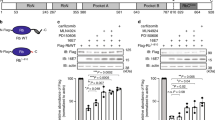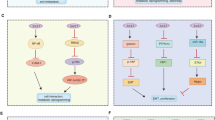Abstract
E7 is the major transforming protein of human papillomavirus (HPV), which is implicated in the development of cervical cancer. The transforming activity of E7 has been attributed in part to its interaction with the retinoblastoma (Rb) tumour suppressor; however, the Rb interaction alone is not sufficient for transformation by E7. In a screen for cellular targets of HPV E7, we identified the Ski interacting protein, Skip, as a new interacting partner of E7. We show that HPV-16 E7 associates with Skip via sequences in its carboxy terminal region, and the evolutionarily conserved proline rich sequences (PRS) of the SNW domain of Skip. E7 functionally targets Skip in vivo and inhibits its transcriptional activation activity. Two transformation defective mutants of E7 were identified that failed both to bind Skip and to inhibit its transcriptional activity. These results suggest that inhibition of Skip function may contribute to cell transformation by HPV-16 E7.
This is a preview of subscription content, access via your institution
Access options
Subscribe to this journal
Receive 50 print issues and online access
$259.00 per year
only $5.18 per issue
Buy this article
- Purchase on Springer Link
- Instant access to full article PDF
Prices may be subject to local taxes which are calculated during checkout








Similar content being viewed by others
References
Androphy E, Hubbert N, Schiller J, Lowy D . 1987 EMBO J. 6: 989–992
Banks, L, Edmonds C, Vousden KH . 1990 Oncogene 5: 1383–1389
Banks L, Spence P, Androphy E, Hubbert N, Matlashewski G, Murray A, Crawford L . 1987 J. Gen. Virol. 68: 1351–1359
Barbosa M, Edmonds C, Fischer C, Schiller JT, Lowy D, Vousden K . 1990 EMBO J. 9: 153–160
Baudino TA, Kraichely DM, Jefcoat SC, Winchester SK, Partridge NC, MacDonald PN . 1998 J. Biol. Chem. 273: 16434–16441
Caldeira S, de Velliers EM, Tommasino M . 2000 Oncogene 19: 821–826
Chellappan S, Kraus VB, Kroger B, Münger K, Howley PM, Phleps WC, Nevins JR . 1992 Proc. Natl. Acad. Sci. USA 89: 4549–4553
Dahl R, Wani B, Hayman MJ . 1998 Oncogene 16: 1579–1586
Durfee T, Becherer K, Chen PL, Yeh SH, Yang Y, Kilburn AE, Lee WH, Elledge SJ . 1993 Genes Dev. 7: 555–569
Dyson N, Howley PM, Munger K, Harlow E . 1989 Science 243: 934–936
Edmonds C, Vousden K . 1989 J. Virol. 63: 2650–2656
Hawley-Nelson P, Vousden K, Hubbert N, Lowy D, Schiller J . 1989 EMBO J. 8: 3905–3910
Jansen-Dürr P . 1996 Trends Genet. 12: 270–275
Jewers RJ, Hildebranadt P, Ludlow JW, Kell B, McCance DJ . 1992 J. Virol. 66: 1329–1335
Kühne C, Banks L . 1998 J. Biol. Chem. 273: 34302–34309
Luckow B, Schutz G . 1987 Nucleic Acids Res. 15: 5490
Massimi P, Pim D, Banks L . 1997 J. Gen. Virol. 78: 2601–2613
Münger K, Phelps WC, Bubb V, Howley PM, Schlegel R . 1989 J. Virol. 63: 4417–4421
Murthy SC, Bhat GP, Thimmappaya B . 1985 Proc. Natl. Acad. Sci. USA 82: 2230–2234
Phelps WC, Yee CL, Münger K, Howley PM . 1988 Cell 53: 539–547
Pim D, Storey A, Thomas M, Massimi P, Banks L . 1994 Oncogene 9: 1869–1876
Prathapam T, Kühne C, Hayman M, Banks L . 2001 Nucleic Acids Res. 29: 3469–3476
Quin XQ, Chittenden T, Livingston DM, Kaelin Jr WG . 1992 Genes Dev. 6: 953–964
Sanger F, Nicklen S, Coulson AR . 1977 Proc. Natl. Acad. Sci. USA 74: 5463
Smotkin D, Wettstein F . 1986 Proc. Natl. Acad. Sci. USA 83: 4680–4684
Stavnezer E, Gerhard DS, Binari C, Balzas I . 1981 J. Virol. 39: 920–934
Storey A, Pim D, Murray A, Osborn K, Banks L, Crawford L . 1988 EMBO J. 7: 1815–1820
Tokitou F, Nomura T, Khan MM, Kaul SC, Wadhwa R, Yasukawa T, Kohno I, Ishii S . 1999 J. Biol. Chem. 274: 4485–4488
Watanabe S, Kanda T, Yoshiike K . 1990 J. Virol. 64: 207–214
Werness BA, Levine AJ, Howley PM . 1990 Science 248: 76–79
Zhou S, Fujimuro M, Hsieh JJ-D, Chen L, Hayward SD . 2000 J. Virol. 74: 1939–1947
zur Hausen H, Schneider A . 1987 In: Salzman, NP, Howley, PM (eds). The papillomaviruses Plenum Publishing Corp.: New York pp 245–263
Acknowledgements
We are very grateful to Paola Massimi and David Pim for the Δ52–56 E7 mutant and their help and advice. We are also very grateful to Mike Hayman for his gift of pCGSP-Skip and pMT2-Ski expression plasmids. We would like to thank Gianni del Sal for the pRb expression construct and Mauro Sturnega for the help in the production of antibodies. We would also like to thank Miranda Thomas for her comments on the manuscript. This work was supported in part by research grants from the Associazione Italiana per la Ricerca Sul Cancro and the EU Biomed 2 program.
Author information
Authors and Affiliations
Rights and permissions
About this article
Cite this article
Prathapam, T., Kühne, C. & Banks, L. The HPV-16 E7 oncoprotein binds Skip and suppresses its transcriptional activity. Oncogene 20, 7677–7685 (2001). https://doi.org/10.1038/sj.onc.1204960
Received:
Revised:
Accepted:
Published:
Issue Date:
DOI: https://doi.org/10.1038/sj.onc.1204960
Keywords
This article is cited by
-
Expression and prognostic role of SKIP in human breast carcinoma
Journal of Molecular Histology (2014)
-
AtSKIP functions as a mediator between cytokinin and light signaling pathway in Arabidopsis thaliana
Plant Cell Reports (2014)
-
Functional identification of AtSKIP as a regulator of the cell cycle signaling pathway in Arabidopsis thaliana
Journal of Plant Biology (2012)
-
Overexpression of STAT3 in HPV-mediated cervical cancer in a North Indian population
Molecular and Cellular Biochemistry (2009)
-
Genome wide expression analysis in HPV16 Cervical Cancer: identification of altered metabolic pathways
Infectious Agents and Cancer (2007)



